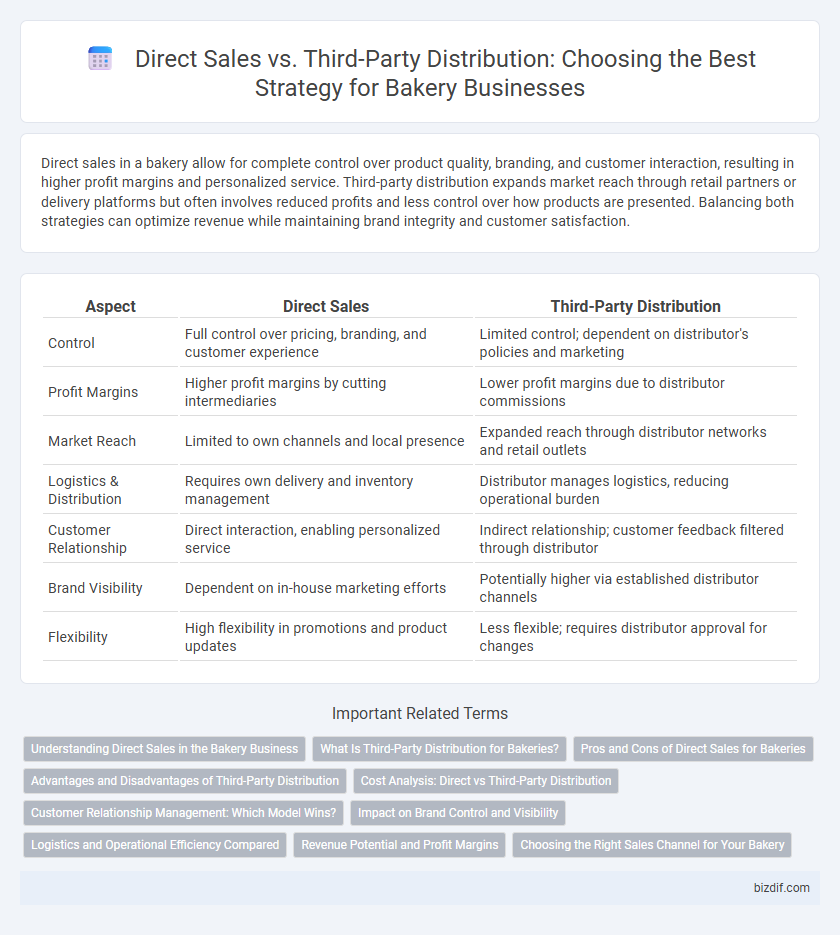Direct sales in a bakery allow for complete control over product quality, branding, and customer interaction, resulting in higher profit margins and personalized service. Third-party distribution expands market reach through retail partners or delivery platforms but often involves reduced profits and less control over how products are presented. Balancing both strategies can optimize revenue while maintaining brand integrity and customer satisfaction.
Table of Comparison
| Aspect | Direct Sales | Third-Party Distribution |
|---|---|---|
| Control | Full control over pricing, branding, and customer experience | Limited control; dependent on distributor's policies and marketing |
| Profit Margins | Higher profit margins by cutting intermediaries | Lower profit margins due to distributor commissions |
| Market Reach | Limited to own channels and local presence | Expanded reach through distributor networks and retail outlets |
| Logistics & Distribution | Requires own delivery and inventory management | Distributor manages logistics, reducing operational burden |
| Customer Relationship | Direct interaction, enabling personalized service | Indirect relationship; customer feedback filtered through distributor |
| Brand Visibility | Dependent on in-house marketing efforts | Potentially higher via established distributor channels |
| Flexibility | High flexibility in promotions and product updates | Less flexible; requires distributor approval for changes |
Understanding Direct Sales in the Bakery Business
Direct sales in the bakery business involve selling products directly to customers through storefronts, farmers markets, or online platforms, ensuring freshness and personalized customer interactions. This approach allows bakers to maintain control over pricing, brand experience, and customer feedback, which can enhance product quality and loyalty. By bypassing intermediaries, bakeries can optimize profit margins and build stronger, more transparent relationships with their target market.
What Is Third-Party Distribution for Bakeries?
Third-party distribution for bakeries involves partnering with external companies to handle the storage, transportation, and delivery of baked goods to retailers or customers. This method allows bakeries to expand their market reach without investing heavily in logistics infrastructure or delivery fleets. Relying on specialized distributors can ensure timely delivery and maintain product quality across various sales channels.
Pros and Cons of Direct Sales for Bakeries
Direct sales in bakeries offer stronger brand control, higher profit margins, and direct customer feedback, enabling customized product offerings and enhanced customer loyalty. However, they require substantial investment in marketing, sales infrastructure, and logistical management, which can strain small businesses. Limited reach compared to third-party distributors also restricts market expansion and can increase the time needed to scale operations efficiently.
Advantages and Disadvantages of Third-Party Distribution
Third-party distribution in the bakery industry expands market reach and reduces the need for in-house logistics, enabling bakers to focus on product quality and innovation. However, reliance on external distributors can lead to lower profit margins and less control over branding and customer experience. Challenges also include potential delays, inconsistent product handling, and dependence on the distributor's performance.
Cost Analysis: Direct vs Third-Party Distribution
Direct sales in a bakery typically reduce costs associated with third-party fees and commissions, increasing profit margins per product sold. Third-party distribution entails expenses like retailer markups, logistics, and platform fees, which can significantly cut into the bakery's revenue. Evaluating these cost components helps optimize pricing strategies and maximize overall profitability.
Customer Relationship Management: Which Model Wins?
Direct sales in bakery businesses foster stronger customer relationship management by enabling personalized interactions, immediate feedback, and tailored service that boost customer loyalty and satisfaction. Third-party distribution often limits direct contact, reducing opportunities for bakeries to gather insights and build a unique brand experience. For bakeries aiming to optimize customer engagement and retention, direct sales present a more effective model to cultivate long-term relationships.
Impact on Brand Control and Visibility
Direct sales in the bakery industry enhance brand control by allowing businesses to manage customer experience, product presentation, and pricing strategies without intermediaries. Third-party distribution expands market reach and increases visibility through established retail networks but often dilutes brand identity due to less control over product placement and marketing. Balancing direct sales and third-party distribution is crucial for bakeries aiming to maintain strong brand presence while maximizing customer access.
Logistics and Operational Efficiency Compared
Direct sales in bakery operations streamline logistics by eliminating intermediaries, enabling faster delivery and fresher product availability. Third-party distribution offers broader market reach but introduces complexity in supply chain management and potential delays due to multiple handling points. Efficient inventory control and real-time tracking are critical in both models to maintain product quality and meet customer demand.
Revenue Potential and Profit Margins
Direct sales in a bakery maximize revenue potential by allowing full control over pricing and customer experience, leading to higher profit margins. Third-party distribution expands market reach and volume but typically involves lower margins due to wholesale pricing and fees. Balancing both strategies can optimize overall bakery profitability by leveraging direct customer relationships and broader distribution channels.
Choosing the Right Sales Channel for Your Bakery
Selecting the optimal sales channel for your bakery significantly impacts profit margins and customer reach. Direct sales through in-store purchases or farmers' markets allow for higher control over brand experience and fresh product delivery, while third-party distribution, such as partnering with local grocery stores or online food platforms, expands market access and scales volume quickly. Evaluating factors like production capacity, target audience, and marketing resources helps determine the ideal mix between direct engagement and external distribution networks for sustained bakery growth.
Direct Sales vs Third-Party Distribution Infographic

 bizdif.com
bizdif.com